Spinal manipulation continues to be a heavily debated topic due to its possible adverse events & specifically the risk of causing undue stress on the vertebral arteries in the V3 segment with a rotational manuever. However, it continues to be an effective procedure for cervical spine dysfunctions and may be more effective than massage or mobilizations.
In fact, the effective delivery of manipulation over mobilization/massage could make sense to the practitioner based off of clinical results (personal experience) but also basic science from the findings of Bolton and Budgell 2006, which suggest,
that manipulation provides an immediate and short-term stimulus to the intervertebral tissues and that it is unlikely that deep short intervertebral muscles would be similarly activated when manual therapy is applied to superficial tissues

The application of spinal manipulation, especially to the upper cervical spine, is still contentious. Even with this disputable intervention, there are multiple accounts of the use of spinal manipulation in the literature for the treatment of cervicogenic dizziness (to name a few – Cote 1991, Uhlemann 1993, Bracher 2000, Galm 1998)
In fact, Heikkila et al 2000 found when comparing acupuncture, NSAIDs and cervical manipulation that,
spinal manipulation may impact most efficiently on the complex process of proprioception and dizziness of cervical origin
However, the leading expert in cervicogenic dizziness, Dr. Timothy Hain, disagrees with the use of spinal manipulation with this quote:
we generally think that chiropractic treatment is not a good idea for vertigo of any type, including cervical vertigo
Granted, Hain is speaking of chiropractic but we all know this relates directly to manipulation.
Additionally, Fraix M et al 2013, an osteopathic physician and his group that has studied the effects of osteopathic manipulative therapy in a pilot study in 2010, then again in 2013 and Papa in 2017, purposely did not manipulate the upper cervical spine due to “possibly a pronounced effect on the vestibular system”. Further, many clinicians note that non-thrust techniques may better serve the suboccipital region.
Thus, the literature is still pending on the use of spinal manipulation for the management of cervicogenic dizziness as it does not always seem logical (Duquesnoy & Catanzariti 2008). Beyond the scope of this piece but very relevant is the type of manipulation in a patient with dizziness—such as, would it be more appropriate to perform a non-momentum induced thrust vs momentum induced thrust in someone with dizziness induced by head on neck positions?
The author of this manuscript considers spinal manipulation, but knows the effectiveness of other articular and non-articular methods of manual therapy. It is not to say spinal manipulation isn’t safe, as it can be very safe if provided in the right context. The application of one over the other entails many facets of patient management, including psychomotor skills, prior experience (patient and clinician) and a thorough assessment.
What are your thoughts? What kind of experience do you have with this topic?
Discounts for my Seminal Course! (expires July 28th at midnight!)
if signing up with colleagues (3 or more)
Use code: Group for $50 off each
or if signing up as student or new grad (within 2017)
Use code: STUDENTCGD for 70% off!
You can learn more about the screening and treatment process of Cervicogenic Dizzinesss through Integrative Clinical Concepts, where the author and his wife, a Vestibular Specialist, teach a 2-day course. Pertinent to this blog post, the 2nd day includes the “Physio Blend”, a multi-faceted physiotherapist approach to the management of Cervicogenic Dizziness, which includes treatments of the articular and non-articular system of manual therapy and the most updated sensorimotor exercise regimen.
If you would like to host a course for your staff (either a vestibular, neuro, sports or ortho clinic), please do not hesitate to contact me at harrisonvaughanpt@gmail.com for prices and discounts.
Authors
Harrison N. Vaughan, PT, DPT, OCS, Dip. Osteopracic, FAAOMPT
Instructor: Cervicogenic Dizziness for Integrative Clinical ConceptsPhysical Therapist at In Touch Therapy, South Hill, VA
Danielle N. Vaughan, PT, DPT, Vestibular Specialist
Instructor: Cervicogenic Dizziness for Integrative Clinical ConceptsVestibular Physical Therapist at Drayer Neurological Clinic, Raleigh, NC
Want an approach that enhances your existing evaluation and treatment? No commercial model gives you THE answer. You need an approach that blends the modern with the old school. Live cases, webinars, lectures, Q&A, hundreds of techniques and more! Check out Modern Manual Therapy!
Keeping it Eclectic...













Post a Comment
Post a Comment